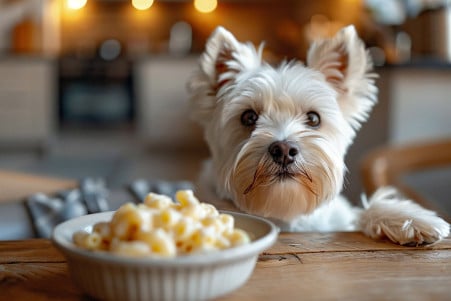Can Dogs Eat Blue Cheese? Understanding the Risks
18 February 2024 • Updated 16 February 2024

While blue cheese is a delicious treat for humans, it is not safe for dogs to eat. This is because blue cheese contains roquefortine C, which can lead to vomiting, diarrhea, seizures, and other serious side effects. The high fat content in blue cheese can also be dangerous. If your dog eats blue cheese, watch for symptoms and call your vet right away.
To better understand the risks of giving blue cheese to dogs, we will look at research from a variety of fields, including veterinary research on the impact of different foods on dogs, toxicology research on mycotoxins, and animal nutrition research.
By doing this, we can better understand the immediate risks of blue cheese and why it is bad for dogs in general, which will help you make better choices about what to feed your dog.
Can dogs eat blue cheese?
Roquefortine C Toxicity in Dogs
The fungus Penicillium roqueforti produces Roquefortine C, a mycotoxin, during the fermentation process in some blue cheeses. While the levels of roquefortine C in blue cheese are not considered a significant health hazard to humans, the toxin can be particularly dangerous to dogs.
When dogs ingest roquefortine C, they can experience a range of toxic effects, including vomiting, convulsions, and seizures. An acute case documented in the literature described a Labrador retriever experiencing such severe symptoms that it required veterinary intervention, including medication to control seizures and induced vomiting for decontamination.
If a dog has ingested blue cheese, it is important to seek veterinary care immediately. The initial signs of toxicity can progress rapidly, and early intervention may help to avoid serious complications or death.
If your dog has eaten blue cheese, it is important to monitor them for signs of distress and seek veterinary care as soon as possible. While not all blue cheese contains high levels of roquefortine C, the potential risk it poses means dog owners should avoid giving this food to their pets.
The potential dangers of roquefortine C are also increased by other factors, including the high fat content in blue cheese, which can lead to other health issues in dogs.
The Dangers of High-Fat Foods: Blue Cheese and Dogs
While dogs may be drawn to the smell and taste of cheese, their bodies are not designed to process the high fat content found in varieties like blue cheese. According to DogTime, cheese is high in fat and can lead to obesity in dogs, a problem that is on the rise in the pet community.
The high fat content in blue cheese can also cause pancreatitis, a painful and potentially life-threatening condition in dogs. Symptoms like abdominal pain, vomiting, and diarrhea are common signs of pancreatitis, which is a direct result of consuming high-fat foods.
Purina recommends that dog owners stick to low-fat and low-sodium cheeses like cottage cheese if they want to give their pets a special treat without putting their health at risk.
Cottage cheese is a much safer and healthier option than blue cheese and other high-fat cheeses. However, when it comes to giving dogs cheese as a treat, it’s important to remember that the key is to do so in moderation.
While small amounts of cheese can be safe and fun for dogs, the type of cheese you choose matters. For example, cheddar is often a better choice than blue cheese because it has less fat and doesn’t contain mycotoxins.
Given the risks of high-fat foods, dog owners should make sure to choose treats that are low in fat and free of toxins to ensure their pets stay healthy.
Mycotoxin Contamination in Pet Food
Molds are a common source of mycotoxins, which are secondary metabolites that can contaminate agricultural commodities, including those used in pet food. According to a PubMed review, mycotoxins, such as aflatoxins, ochratoxin A, and Fusarium mycotoxins, can be found in both raw materials and finished pet food products, and can therefore pose a danger to companion animals.
Mycotoxin contamination can lead to acute mycotoxin poisoning or chronic health problems in pets, such as liver issues and immunosuppression.
The pet food industry has implemented a number of measures to control mycotoxin contamination. These measures include the use of processing technologies like sifting and ozonation and the use of feed additives that can help reduce the negative effects of mycotoxins in contaminated pet food.
In addition, a PubMed article emphasizes the importance of a systematic risk assessment framework for ensuring mycotoxin safety, which involves the identification of hazards and the determination of tolerable intake levels.
Pet parents can reduce the risk of mycotoxin exposure by selecting pet foods with high-quality ingredients and transparent supply chains and by keeping up with recalls and manufacturer information. In addition, pet parents can help ensure their pets’ safety by keeping up with mycotoxin legislation and safety requirements and making sure the pet food they choose meets the necessary safety standards.
Decoding the Menu: What Dogs Should and Shouldn’t Eat
Knowing what human foods are safe and dangerous for dogs is important for their health. While dogs are omnivores and can eat a variety of human foods, not all human foods are safe for dogs to eat, according to Purina.
The American Kennel Club lists carrots, green beans, and cooked chicken as examples of human foods that are good for dogs, while chocolate and grapes are examples of human foods that are toxic to dogs.
Dogs can also be allergic to certain foods, and common dog food allergens include dairy, beef, and wheat. Veterinary experts recommend healthy options like cooked, unseasoned chicken and pumpkin, which are full of nutrients and fiber, while they advise against feeding dogs avocado, which is toxic to many animals, and xylitol, which is a sweetener that can cause liver failure in dogs.
The effects of feeding dogs human foods that are not safe for them can range from mild digestive issues to life-threatening poisoning. Because every dog has different dietary needs, it’s important to talk to a vet to get personalized recommendations.
By learning about the nutritional needs of dogs and the dangers of certain foods, dog owners can make better choices about treats and avoid putting their pets at risk. This will help ensure that dog owners are giving their pets the right nutrition, in addition to love, to help them live their best lives.
Final Thoughts: Can Dogs Eat Blue Cheese?
In summary, the dangers of giving blue cheese to dogs are both well-documented and serious. Both Roquefortine C—an mycotoxin that is toxic to dogs—and the high fat content in blue cheese can lead to a range of health problems, from gastrointestinal issues to more severe and potentially life-threatening problems like pancreatitis and seizures.
The bottom line is that if you feed your dog this type of cheese, you could end up making an unexpected trip to the vet.
Our dogs’ health is directly impacted by the food we choose to give them. As a result, it’s important for us to make informed decisions that prioritize their well-being and avoid known dangers. While it’s true that the occasional treat is a fun part of our dogs’ lives, it’s important to make sure that we’re picking treats that are safe for them to eat.
If you have questions about your dog’s diet or the safety of certain foods, it’s best to talk to a professional. Vets can offer the most accurate and personalized advice. By working with a vet, you can make sure that your dog is set up for a healthy, happy, and safe life.


